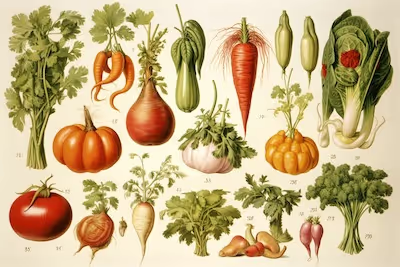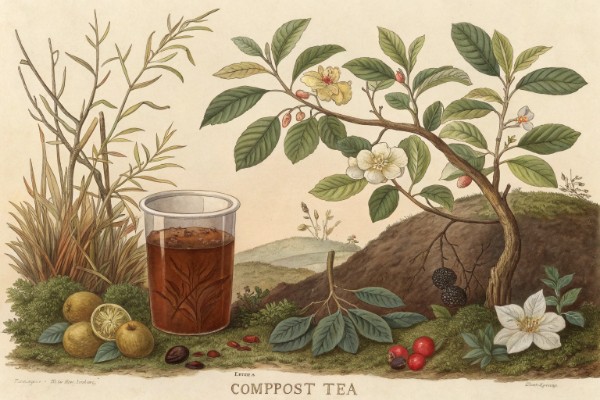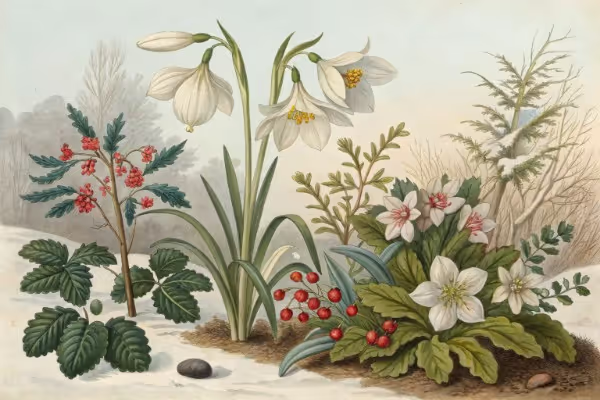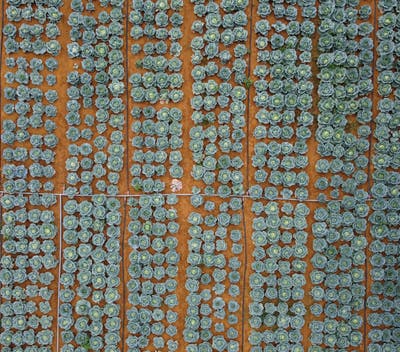Cotyledons: The Essential Role of the Seed's First Leaves
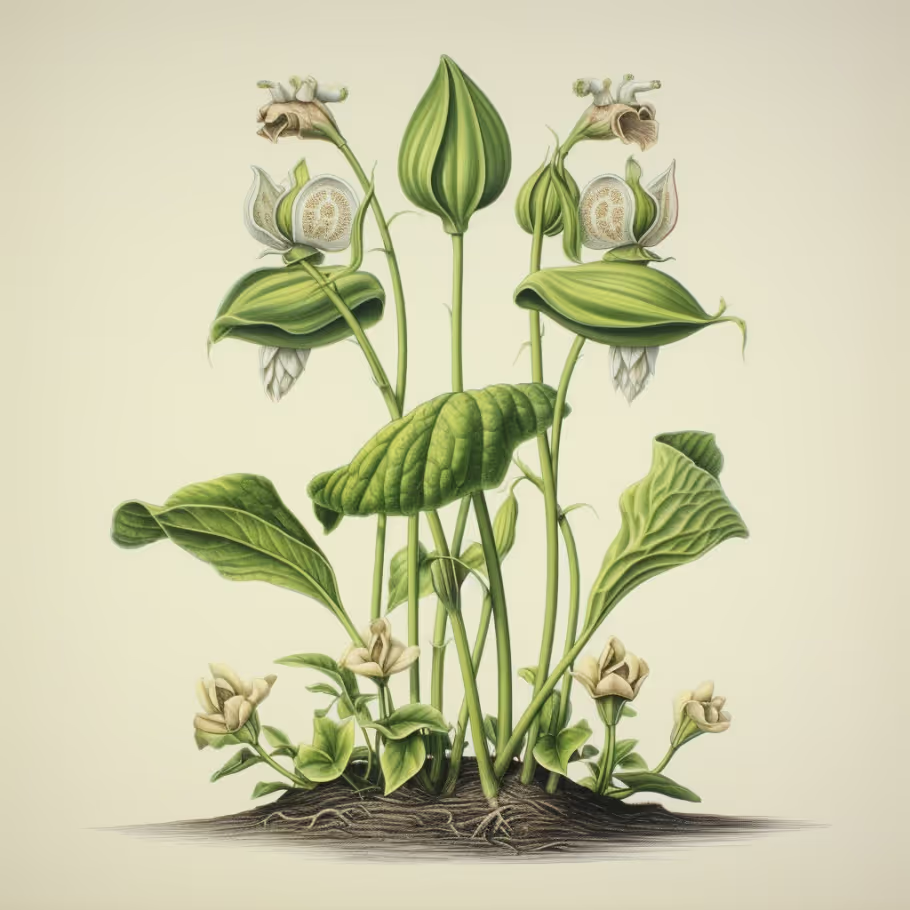
Cotyledons
Spotting cotyledons cues you into your seedling's story—these first leaves store nutrients, fueling early growth. Knowing your cotyledons allows quick identification of healthy seedlings and signals the perfect moment to transplant. Read on to decode how cotyledons shape plant success and guide your gardening strategy.
Cheatsheet: Cotyledon Care & Power Guide
🌱 Cotyledon Functions
- Store nutrition for seedling's first days
- Kickstart photosynthesis before true leaves
- Signal seedling health—yellowing = stress
🌡️ Germination Conditions
- 70–75°F (21–24°C) optimal for most species
- Keep soil moist, not soggy
- Use sterile seed-starting mix
- Provide gentle light within 24 hours of sprout
💡 Care Tips for Seedling Stage
- Rotate trays daily for upright growth
- Allow top ½ in. (1 cm) dry before watering
- Keep under grow lights 12–16 hrs/day
- Avoid liquid fertilizer until first true leaves
- Thin to 1 plant/cell when cotyledons fully open
🥬 Nutrition & Self-Sufficiency
- Microgreens harvested at cotyledon stage: up to 40x nutrient density of mature plants
- Fast, homegrown vitamins; harvest in 7–14 days
- Edible cotyledons: broccoli, radish, sunflower
🧰 Tools and Products You'll Need
- Sterile seed-starting mix
- Seeds (choose edible varieties for microgreens)
- Spray bottle for gentle watering
- Seed tray with humidity dome
- LED grow light or bright window
- Heat mat (for cool rooms)
- Small fan for airflow
- Labels for tracking varieties
🔑 Fast Steps: From Sowing to Strong Seedlings
- Sow seeds 1/8–¼ in. (3–6 mm) deep in moist mix
- Cover with dome; place on heat mat if <68°F (20°C)
- Remove dome once cotyledons appear
- Move to light; keep 2–3 in. (5–8 cm) above seedlings
- Water only when surface is dry to touch
- Thin seedlings after cotyledons open
- Begin fertilizer after true leaves form
Cotyledons: the seed’s first leaves at work
Cotyledons are the seed’s starter kit, part pantry, part solar panel, and often the best early health check you’ll ever get. I watch them the way a barista watches crema.
“Cotyledon: the first leaf or one of the first pair of leaves produced by the embryo of a seed plant.” Merriam-Webster Dictionary
Some species push cotyledons into the light and turn them emerald within hours, others keep them buried as fat storage organs that never see the sun. That difference matters for how you sow, light, and transplant.
Monocots, dicots, and two ways seedlings break ground
I plan care around two germination styles that shape cotyledon behavior. The labels sound arcane, but the fieldcraft is simple.
- Epigeal germination: cotyledons rise above the soil and green up, as in beans, sunflowers, squash, and tomatoes.
- Hypogeal germination: cotyledons stay below ground as storage, as in peas, broad beans, many trees including oaks.
- Monocots have one cotyledon with its own quirks, like onions forming a loop that tugs the seed coat free at the surface.
What cotyledons actually do
I lean on three jobs they handle while roots and true leaves catch up. Understanding these jobs saves trays.
- Fuel reserve: oils in cucurbits and brassicas, proteins in legumes, starches in many ornamentals power early growth, which is why I avoid fertilizer until true leaves expand.
- Photosynthesis jumpstart: once exposed to light, cotyledons build chloroplasts and start paying their own way, a shift called photomorphogenesis.
- Signals: hormones like auxin and gibberellin move from cotyledons to roots, steering elongation, branching, and the first taproot push.
Royal Horticultural Society notes that early missteps at the seedling stage often decide success, because these tissues carry both food and the plant’s first photosynthetic machinery. RHS, Seed sowing and care
Field notes I trust
I once clipped a pair of cucumber cotyledons while pricking out and lost two weeks of growth, which taught me to lift by the seed leaves only if I must and to work with a dibber. On tomatoes, I bury stems up to the cotyledons for extra rooting and never remove those leaves unless diseased.
- Transplant after the first true leaves appear and roots knit the mix, not at the thread-root stage unless the species tolerates it like brassicas.
- Feed only when cotyledons fade from bright green to pale lime, then start at 50 to 75 ppm N or a quarter-strength organic feed.
- If both cotyledons are damaged, reduce light intensity a notch, increase root-zone warmth by 2 to 3 F 1 to 2 C, and avoid any salt stress.
Light that keeps cotyledons compact
Cotyledons read light quality like a street poet reads a crowd, and they respond fast. I aim for a gentle but adequate photon budget to prevent stretch without scorching.
- Provide 150 to 250 µmol m-2 s-1 at canopy for most seedlings with a 14 to 16 hour photoperiod under full-spectrum LEDs around 4000 to 5000 K.
- Hang fixtures 6 to 12 inches 15 to 30 cm above the canopy and use a dimmer to fine-tune, since different species and ages vary in appetite.
- Keep day temps near 68 to 75 F 20 to 24 C and nights a touch cooler at 60 to 65 F 16 to 18 C to tighten internodes and broaden cotyledons.
Air, water, and media so cotyledons stay clean
I want the seed leaves dry and the root zone evenly moist. That pairing cuts losses and accelerates first true leaves.
- Use a sterile, fine seed-starting mix with ample pore space, like peat or coco plus perlite and a dusting of vermiculite for capillarity.
- Bottom-water to about two-thirds of container height, then let the surface dry to the color of fresh sand before the next watering.
- Provide a light fan to ripple foliage, which discourages damping-off organisms like Pythium and Rhizoctonia.
“Damping-off is caused by several soilborne fungi and oomycetes that kill seedlings.” University of Minnesota Extension
Cotyledon shapes that help me weed with confidence
I patrol beds and trays by silhouette and texture, which keeps me from yanking the wrong baby. The trick is to memorize a few families.
- Brassicas: nearly round to kidney-shaped cotyledons with a faint notch, matte surface, and pale midrib.
- Tomato and pepper: narrow, lance-like cotyledons with a glossy sheen and parallel veins.
- Cucurbits: big paddle-shaped cotyledons that smell cucumbery when bruised, a helpful tell in mixed beds.
- Grasses and cereals: single linear blade from one cotyledon, often folded or rolled, no paired leaves.
Care differences across crops that tie back to cotyledons
Species habits make me change both timing and touch. Here is how I adjust.
- Cucurbits: sow shallow, keep warm, and avoid rough handling since huge cotyledons tear easily.
- Brassicas: can be pricked out at the cotyledon stage if roots are teased gently and watered in promptly.
- Solanaceae: tomatoes tolerate deep planting up to the cotyledons and then grow adventitious roots along buried stems.
- Alliums: give a gritty surface or a light vermiculite top-dress so the emerging cotyledon loop can shed its seed coat cleanly.
- Legumes like peas: sow deeper 1 to 2 inches 2.5 to 5 cm since hypogeal cotyledons feed from below and handle cool soils well.
Gear that makes cotyledon care simple
I buy tools that solve real seed-leaf problems rather than add clutter. These are standouts after too many seasons and too many trays.
- LED fixtures with a published PAR map and a dimmer to hold PPFD in the seedling sweet spot.
- Heat mat with an external thermostat set to 72 F 22 C for warm-season starts and unplugged once cotyledons open.
- Vented humidity dome that opens wide on day three to four to dry the surface before pathogens wake up.
- 72- or 128-cell trays for fine control of moisture, plus air-prune trays for crops that spiral roots quickly.
- Biologicals including Trichoderma and Bacillus amyloliquefaciens drenches at label rates to suppress damping-off pressure.
- Fine mist sprayer for seed-coat helmets, a quick spritz and a minute under cover softens hulls without mauling cotyledons.
Reading cotyledons like a dashboard
They broadcast plant status long before a true leaf sulks, and I act on those signals fast. It feels like catching a soufflé before it falls.
- Pale between veins with good turgor suggests nitrogen need, so I feed lightly and watch color respond within 48 hours.
- Edged burn or cupping says salts or strong light, so I flush the mix and raise the light a few inches.
- Glossy, dark green cotyledons that refuse to expand mean low light or too-warm nights, so I increase PPFD and drop the night temp slightly.
Why keeping cotyledons intact pays dividends
Textbooks and trials converge on the same point I see in the potting shed. Seedlings that retain healthy cotyledons establish faster and resist stress better.
“Cotyledons serve as both storage organs and, in many species, the first photosynthetic leaves.” Taiz, Zeiger, et al., Plant Physiology and Development, Oxford University Press
I avoid pinching or brushing them off during hardening to keep that early engine running. If pests chew them, I prioritize those trays for protection, since the setback lingers.
Light quality trick for thicker cotyledons
A higher red to far-red ratio tightens plants, while a dash of blue broadens cotyledons and deepens color. I favor full-spectrum LEDs that lean slightly blue during the first week, then I warm the spectrum as true leaves arrive.
Sowing depth and cotyledon size go hand in hand
Big cotyledons carry a bigger lunchbox, which lets me sow a touch deeper in dry climates without starving emergence. Tiny-seeded ornamentals with pinhead cotyledons ride just under a dusting of mix or vermiculite for the same reason.
Quick answers to common cotyledon questions
These save calls and save seedlings.
- Yellowing cotyledons after true leaves expand is normal senescence, and I snip only if they touch wet soil or disease spreads.
- Stuck seed coats come off after a mist and a gentle pinch with tweezers, never dry and never yanked sideways.
- Leggy seedlings can be potted deeper if the species roots along stems like tomatoes, but not for species that rot when buried like most cucurbits.
Sources I trust for deeper reading
Royal Horticultural Society, Seed sowing and care, and Pests and diseases pages. Kew Science Glossary for clear definitions and seed biology basics.
University of Minnesota Extension and North Carolina State Extension for damping-off identification and prevention. Taiz and Zeiger, Plant Physiology and Development for the physiology behind cotyledon function.

Want smarter plant choices? 🪴
Frequently Asked Questions About Cotyledons
How can cotyledons signal the health of a seedling?
Cotyledons whisper tales about a plant's early vigor and hint at future vitality. Vibrant, fleshy seed leaves indicate vigorous germination, while wilted or discolored ones warn of nutrient scarcity, overwatering, or fungal trouble beneath the soil's surface. Observing these clues sharpen your gardening intuition.
Do cotyledons perform photosynthesis?
Indeed, cotyledons serve as the initial solar panels for seedlings. These embryonic leaves capture daylight to produce nourishing sugars, fueling the young plant's initial sprint towards growth until the true leaves unfold and assume their duties.
Should gardeners remove cotyledons after true leaves emerge?
Resist the urge to snip these first leaves. Allow cotyledons to naturally wither and withdraw, returning their stored nutrients gracefully back into the seedling. Premature removal deprives the young plant of precious sustenance during these delicate early stages.
Why do some seedlings have one cotyledon while others have two?
Nature loves variety. Monocotyledons like grasses and lilies sprout with a single sleek seed leaf, while dicotyledons such as beans and tomatoes proudly display paired cotyledons. This difference stems from evolutionary lineage, dictating plant structure and growth patterns from the seedling stage onward.
Can cotyledons help identify unknown seedlings?
Absolutely. Observing the shape, size, and number of cotyledons offers vital clues in deciphering a seedling's identity. Familiarity with distinct cotyledon traits sparks insight, guiding gardeners in distinguishing desirable sprouts from rogue weeds early in their lives.
Cotyledons are the quiet workhorses of any seed’s early days. These first leaves punch above their weight, feeding the seedling and lighting the way for true leaves to follow. Spotting healthy cotyledons signals a strong start. If they falter, the seedling’s growth stalls. Keep an eye on these tiny pioneers—they tell you exactly how your plants are faring before roots even hit their stride. Good gardeners know: pay attention early, and the rest comes easier. For more on seedling care and plant know-how, visit taim.io/blog.
Health Benefits of Cotyledons: Tiny Leaves, Big Nutrition
Nutritional Powerhouses at a Glance:
- Concentrated Vitamins: Cotyledons contain elevated Vitamin C, E, and K levels compared to mature leaves.
- Mineral Richness: Provide notable amounts of potassium, iron, magnesium, and calcium, promoting bone density and cardiovascular health.
- Phytonutrient Content: Rich in lutein, beta-carotene, and chlorophyll pigments, supporting eye, skin, and cellular health.
- Fiber Source: Offer dietary fiber to aid digestion, gut flora balance, and overall immunity.
Sprouting for Maximum Nutrient Absorption:
Sprouting seeds increases cotyledon nutrient availability. Broccoli sprouts have up to 50 times more sulforaphane—a powerful antioxidant—than mature broccoli.
Healthy Consumption Recommendations:
- Raw Addition: Sprinkle freshly harvested cotyledons on salads, wraps, smoothies, or soups.
- Optimal Serving: Consume approx. ½ cup (15 grams) daily to meet vitamin and mineral supplementation goals.
- Storage Tip: Refrigerate cotyledons at 38–40°F (3–4°C) in airtight containers, maintaining peak freshness for 5–7 days.
Self-Sufficiency Boost:
Home-grown cotyledons add nutrient density year-round. Quick-sprouting (5–7 days), space-efficient (windowsills or containers), and minimal-resource gardening.
Find out which plants will thrive in your garden!
Answer a few fun questions and get custom plant recommendations perfect for your space. Let’s grow something amazing together!

start your season
